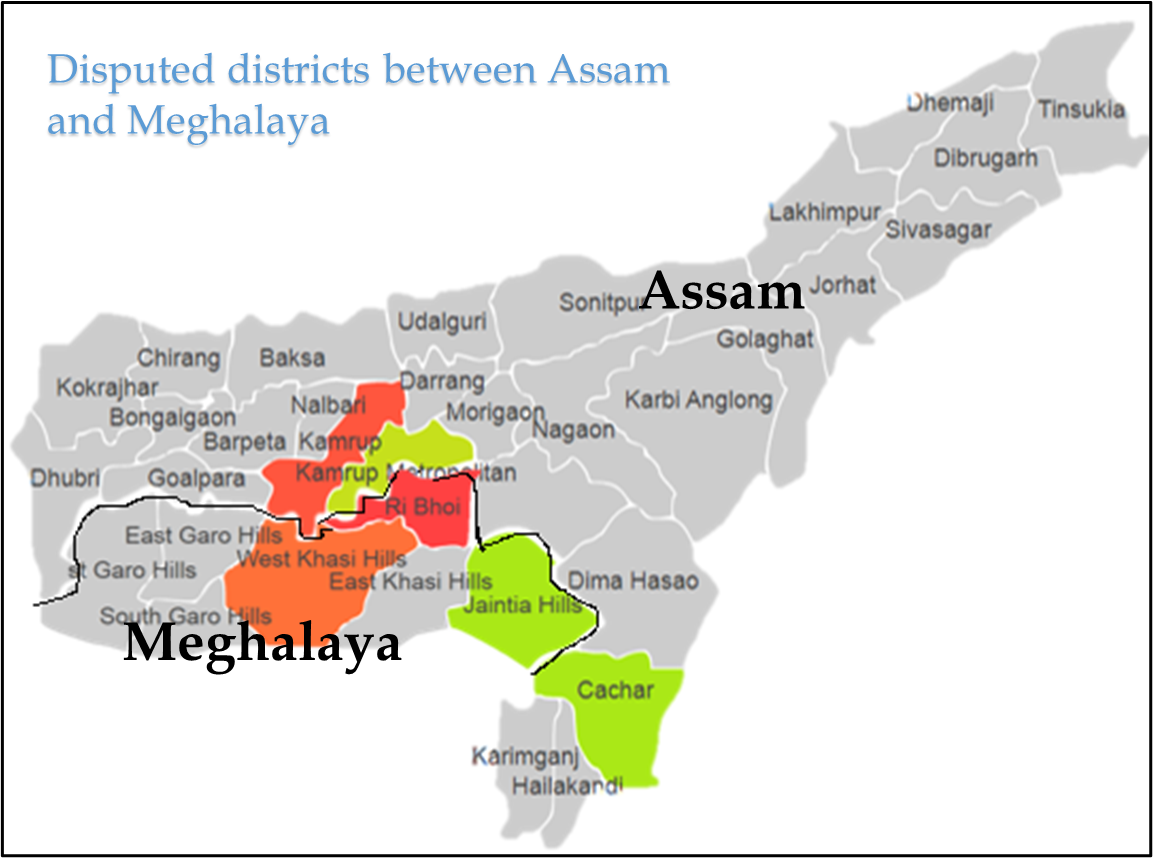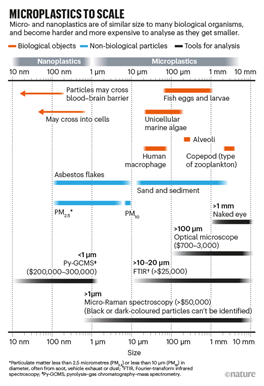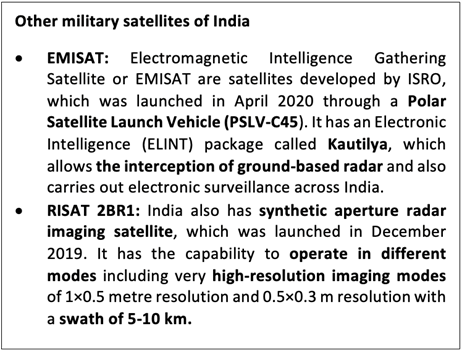Thursday, 31st March 2022
EVs catching fire
In News
With the recent spate of electric two-wheelers catching fire, the central government has now deputed a team to probe the incidents and submit a report and is also expected to develop a strategy and SOPs around handling EV fires.
About the News
- Recently, there have been repeated incidents of Electric two-wheelers made by the likes of Ola, Okinawa and Pure EV, abruptly bursting into flames, bringing to the fore safety issues related to such vehicles, especially the batteries that power them.
- EVs are powered by lithium-ion batteries, of the kind used in cellphones and smartwatches, which are generally considered to be efficient and light compared to their counterparts.
- However, they may also pose a fire risk, as evidenced by the recent incidents.
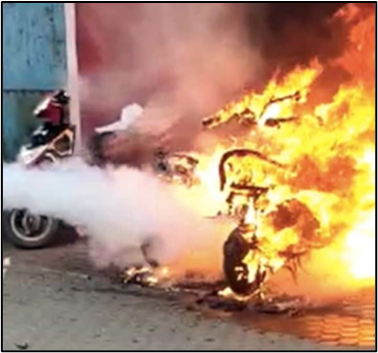
Why are the batteries causing fire?
- Electric two-wheelers are largely powered by lithium-ion battery packs which consist of hundreds of individual battery cells.
- The most common cause of a battery fire is ‘thermal runaway’ in these cells.
- Even when empty, the battery cells contain a small amount of charge. This means that even if a few batteries malfunction and cause a short circuit, it can kickstart a chain reaction resulting in a fire.
- The phenomenon of energy escaping in an uncontrolled fashion is what leads to ‘thermal runaway’.
- Heat and gases fuel even higher temperatures and still more gases, including hydrogen and oxygen, in a self-fulfilling or positive feedback loop until the cells begin to burn and burst.
- A toxic vapour cloud develops, bringing with it the risk of deflagration.
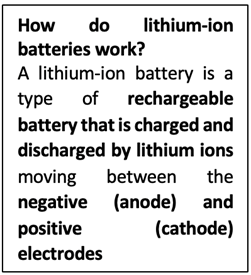
- Preliminary observations have led the companies to believe that the fire in its scooter was a result of short circuiting due to “negligence in charging the vehicle”.
- According to industry experts, a number of reasons, such as manufacturing defects, external damage, or faults in the deployment in the Battery Management Systems could result in these batteries becoming a fire risk.
- Even warmer climate could result in combustion of the battery cells.
How can the thermal runaway be avoided?
- Thermal runaway, which can simply be explained as extreme overheating, can be contained at an early stage with adequate cooling and cell management.
- The latter is a route that many high-end applications of lithium batteries have adopted in the form of battery management system (BMS).
- A BMS is an electronic system that is connected to all the cells in a Li-ion battery pack, which constantly measure their voltage, the current flowing through it and even temperature of the cells.
- If temperatures start rising, that part of the battery pack gets automatically shut off from the rest of the system.
- The cooling system method is employed in electrified performance vehicles.
- However, both these solutions are expensive, and in the case of cooling systems, cumbersome as well.
- This is why a great majority of the electric two-wheelers in India sold today not only have lithium cells of questionable provenance but also are only air-cooled.
Way Forward
- With government encouraging EV sector under FAME-II, it is imperative that policymakers implement stronger monitoring systems to ensure that all vehicle batteries comply with existing standards.
- Apart from government intervention, we can also hope that the manufacturers themselves will learn their lesson from this experience and rejig their approaches and practices.
- Crucially, there will be a cost to these solutions, but if India’s decarbonisation has to work, we need to appreciate that we are a hot country and that heat has consequences for electric vehicles.
Sources:
Trade in ruble
In News
Russia has recently demanded the European countries to pay for all natural gas imports in Russina Ruble instead of the US dollar or the euro.
About the News
- The move to accept payments only in rubles has been done to increase the demand for rubles in the international market.
- The European Union imports nearly 40 per cent of their natural gas requirements from Russia. This step is seen as a set of measures to transfer payment for Russian gas supplies to unfriendly countries including the EU nations, the US and the UK into Russian Rubles.
- The Ruble has been weakening against the dollar in the weeks before Russia invaded Ukraine. It went from being around 75-to-a-dollar to around 85-to-a-dollar.
- However, after the invasion, the ruble’s value plummeted to almost 145 mainly due to sanctions by the Western countries applied on Russia.
- India used to have rupee-ruble direct trade since the early 1950s but the direct rupee ruble trade was formally scrapped in 2005.
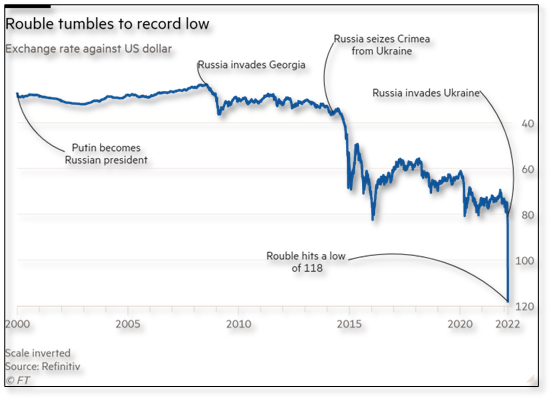
What are the implications of the move?
- Surge in price: Predictably, in the immediate aftermath of this announcement, prices of both natural gas and its substitute crude oil spiked.
- Demand for ruble: Since EU cannot reduce its dependence on energy imports from Russia overnight, the move is accepted to accept payments only in rubles is expected to increase the demand for rubles in the international market.
- Benefit on swap: Russia has already asked its companies that take payment in dollars and euros to swap 80% of their revenue into rubles. While this, too, was a way to create demand for the ruble, the onus was on Russian firms. Under the new diktat, the onus to demand rubles is on the importing countries.
- Impact on India: India’s crude oil imports from Russia have significantly increased over the past That’s because the Russian crude oil (Urals) is available at a deep discount to both the Brent and the West Texas Intermediate (WTI).
- Benefit for Yuan: A rupee-ruble trade will essentially be benchmarked to the Chinese yuan. Benchmarking to yuan, instead of the dollar, would imply that instead of talking about oil prices in dollars per barrel, the price quoted would be in terms of yuan.
Sources:
Proportional Domestic Coal Supply
In News
The Power Ministry had recently stated that in order to make up for any shortfall, it would not be possible to supply coal other than on proportionate basis.
About the News
- As per the ministry, domestic coal supply will be made proportional to the coal received from Coal India Ltd (CIL), Singareni Collieries Company Ltd (SCCL)
- This is ensure that there is adequate supply of coal and to enhance its domestic supply.
Priority Actions Taken
- Allotment to Power Plants maximised: Firstly, the production in captive coal mines that is allotted to power plants would be maximised to the limit permitted by the ministry.
- Lesser number of rakes: Following this, it has been decided that a lesser number of rakes would be made available to such power plants where there is slackness in prompt unloading of coal from rakes.
- This step has been taken to maximise the utilisation of available railway rakes.
- This will be monitored at the state government level and unloading of coal shall be ensured within the given norm.
- The central electricity authority (CEA) has been asked to monitor the unloading time at power plants.
- Bills to be paid in due time: Many generating companies have overdue, running in several hundred crores, affecting the ability of coal companies to continue the supply.
- Therefore, the bills of coal companies must be paid in due time so that coal supplies to such generating companies is not affected on this account.
- Enforcement of Power Purchase Agreement (PPA): The procurer and sellers are legally bound by the PPA (power purchase agreement) signed by both parties.
- While the procurers are bound to pay the bills timely, the gencos (sellers) are bound to maintain adequate fuel stocks and offer availability as per PPA.
- If any gaming is noticed on the part of the seller such as not supplying electricity under PPA and selling in the market should be brought to notice of the Regulatory Commission without any delay under intimation to the Ministry of Power for immediate intervention.
- Mandatory to maintain adequate Fuel Stocks: Not maintaining adequate fuel stocks or not giving availability on any pretext (such as the high price of imported coal etc) will be punishable.
- Mutual Consensus: These issues also need to be resolved based on mutual negotiations transparently.
- States’ Intervention: States must ensure implementation of PPA with Imported Coal Based plants with necessary contractual interventions.
- In extraordinary circumstances, states can use statutory provisions of the Electricity Act 82003 to ensure generation and may approach the ministry for any intervention required in case of an inter-state plant.
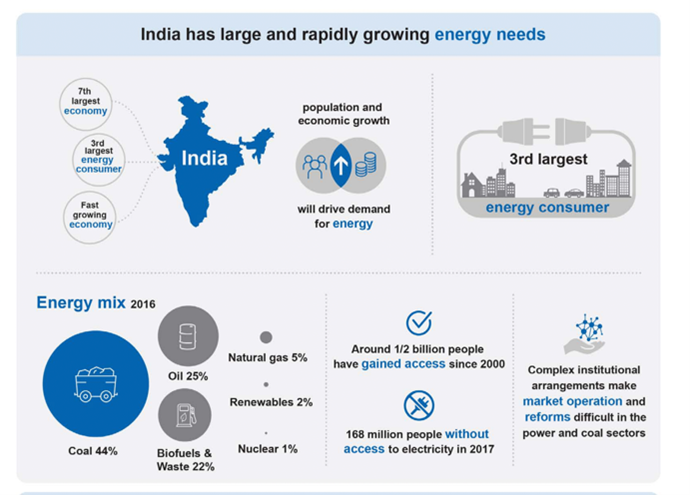
Source:
- Domestic coal supply to be made proportional: Power Ministry
- Domestic coal supply to be made on proportional basis: Power Ministry
Image source:
International Transgender Day Of Visibility
On 31st March, 2009 International Transgender Day of Visibility was celebrated for the first time. To recognize the resilience and accomplishments of the transgender community, around the world, March 31 is celebrated as Transgender Day of Visibility. The aim of the day is to celebrate the trans people, raise awareness about the struggles that they face, and advocate for more protected rights and empower the community. Rachel Crandall of Michigan, United States, a transgender activist, launched the day in 2009 as a response to transgender people's poor recognition and acceptance. Another important cause was her dissatisfaction with the fact that the only well-known transgender-centred day was the Transgender Day of Remembrance, which commemorated transgender persons who had been murdered but did not honour or celebrate surviving transgender people. Transgender Day of Visibility was established as a day to honour and celebrate transgender people who are still alive. Most members of the transgender community are invisible in society, either by choice or out of fear of discrimination. This invisibility, on the other hand, enhances the community's vulnerability by allowing prejudice, violence, and other issues to go unrecognised, unreported, or presumed to be for other reasons.

Sources:
Draft India Data Accessibility & Use Policy 2022
In News
The Ministry of Electronics and Information Technology (MEITY) has recently released a policy proposal titled as, “Draft India Data Accessibility & Use Policy, 2022”.
The policy aims to radically transform India’s ability to harness public sector data while permitting the licensing and sale of public data by the Government to the private sector.
Why is a dedicated data accessibility and use policy important?
- Data is the new oil: With the rise of citizen interaction with public digital platforms and India’s growing digital population, the volume of data is set to grow exponentially.
- Fostering the Digital Economy: India’s ambitions of Trillion Dollar Digital economy need the ability to harness the value of data
- Improving Public Service Delivery: Increased sharing of data across the public and private sectors optimizes digital welfare delivery and increases administrative efficiency, enabling citizen-centric services
- Enhancing Efficiency & Innovation: Improved availability of reliable, high-quality data catalyses digital innovation for the public good, creating new economic opportunities
- Improving Policy Making & Programs Evaluation: Unlocking data strengthens the evidence base for policy development and public administration, bringing targeted social benefits to citizens.
- Data driven culture: Skill investments within the government for building capacity in data science, analytics, emerging technologies, and ethics is crucial for ensuring the dissemination of high-quality data and its use.
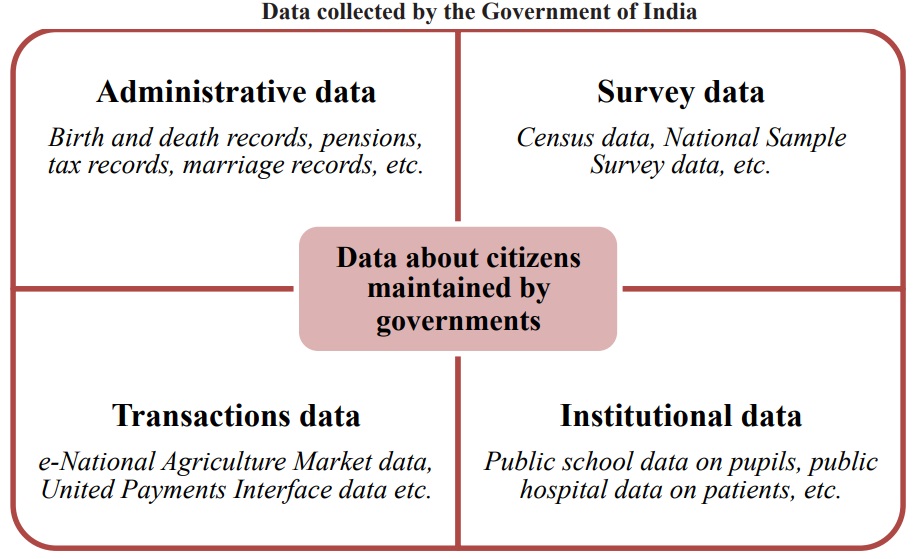
What are the major proposals of the draft policy?
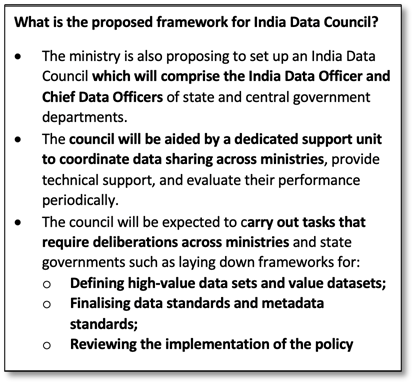
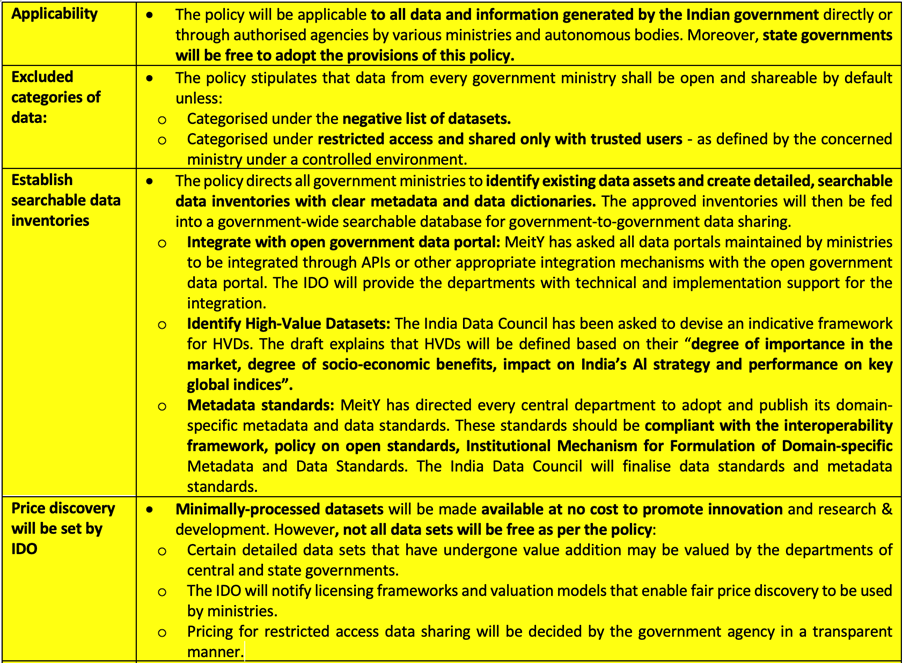
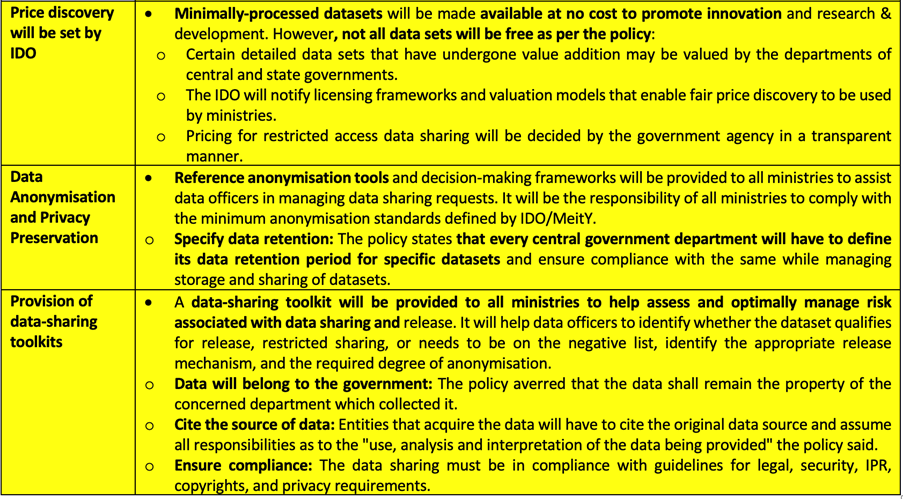
What are the major challenges with the data accessibility policy?
- Contours not defined: The new draft policy has been announced at a time when the country is yet to finalise the contours of a data protection law.
- Push-back from tech-companies: The policy could face pushback from big tech companies whose business model is based on the monetisation of large-scale data collection model.
- Power imbalance: The new draft gives a perverse incentive for the government to collect more citizen data, which in turn may lead to further imbalance of the power imbalance between the state and the citizens.
- Price mechanism: Datasets cannot be priced uniformly, and the value of a particular dataset varies depending on the context in which it is solved.
- Revenue generation: Beside the political risk of gathering more information, another problem with the policy particularly is that when one starts selling citizen data, even if anonymised, the government gets into business it making money. And once one starts making money, it’s very hard to reduce that activity or to regulate it in a manner where you are impartial to the public.
- lack of proper standards: Lack of framework on data anonymisation may be “reverse-engineered”, thereby making re-identification of the generators of the data very easy.
- Privacy factor: The stress on High Value Datasets is worrying since often the most sought-after datasets are those that contain sensitive personal data of individuals, for example medical history, financial data.
- Lack of clarity on defining terms: Some experts have pointed to the lack of details on what constitutes value addition and the pricing or licensing mechanism on the same.
- Undermines federalism: The policy, even though it notes that State governments will be, “free to adopt portions of the policy,” does not specify how such freedom will be achieved. There is also the absence of any comment on whether data gathered from States may be sold by the Central government and whether the proceeds from it will be shared with the States.
Way Forward: With the generation of citizen data is slated to increase exponentially in the next decade and become a cornerstone of India’s $5 trillion-dollar digital economy, a dedicated data accessibility policy is the need of hour. There is need to address issues especially on data privacy beside consultative coordination with various stake holders and inviting views from all sectors including research, academia, startups, and industry on how the policy can institutionalize a data-sharing framework for the next decade.
Question: As Data has emerged as the new oil, discuss the need to have a Data Accessibility policy in India.
Sources:
Robo Roach
This is image of robotised insects created to reach difficult spots in collapsed buildings. The robotised insects were created to reach difficult spots in collapsed buildings that are hard to access due to debris and rubble. The researcher used Madagascan hissing cockroaches and turned them into search agents. The insects are controlled by algorithms that detect life and respond to sensors that are attached as backpacks. They are not remote-controlled. The backpacks have a communication chip, a carbon dioxide sensor, a motion sensor, and an infrared camera. The main purpose of the insects is to detect movements, CO2 levels, and body heat.
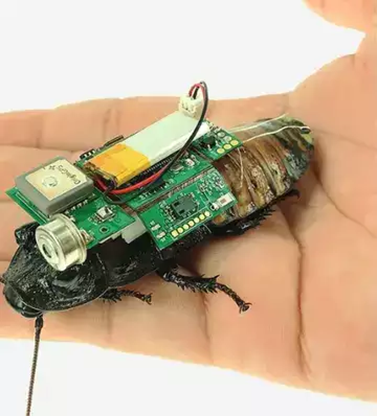
Source:
Sariska Tiger Reserve
- Context: A massive fire has recently broken out in the Sariska Tiger Reserve.
- Sariska Tiger Reserve is located in Alwar district, Rajasthan.
- Situated in the Aravalli hills, it stretches over an area of 881 km2comprising scrub-thorn arid forests, dry deciduous forest, grasslands, and rocky hills.
- Sariska was declared a wildlife sanctuary in 1955 and later declared a tiger reserve in 1978 making it a part of India's Project Tiger.
- The wildlife sanctuary was declared a national park in 1982, and is the first reserve in the world with successfully relocated tigers.
- It is an important biodiversity area in the Northern Aravalli leopard and wildlife corridor.
- The Reserve is known for its rich flora and fauna, especially the Royal Bengal Tiger.
- The park also houses populations of leopards, Nilgai, Sambar, chital, Indian peafowl, great Indian horned owls, vultures, etc.
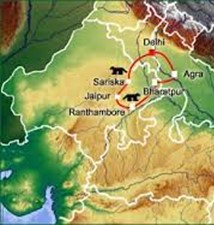
Source:
Image source:
'In Memoriam' montage: Oscar Awards
- Context: The non-featuring of two Indians- Lata Mangeshkar and Dilip Kumar in the ‘In Memoriam’ segment at the Oscars have left some fans disappointed.
- The 'In Memoriam' montage at the Oscars is one of the most-watched, popular, and examined sections in the Oscar ceremony that features images and videos of those who have left an indelible mark in the world of cinema.
- Though initiated in 1978, the ceremony became an annual feature since 1994 that would honour actors, film crew members, and mostly Hollywood movie executives.
- The decision about who makes it to the ‘In Memoriam’ montage is with an executive committee representing every branch of cinema and is created by the Academy.
- On average, the committee looks at about 500-600 profiles before deciding who makes the cut.
- The members of the Committee then pare it down to a more practical number (about 200) which is put out on the website and further cuts it down to about 45 names.
- The Academy Awards, popularly known as the Oscars, are awards for artistic and technical merit in the film industry given annually by the Academy of Motion Picture Arts and Sciences (AMPAS).

Source:
- Explained: Dilip Kumar, Lata missing in Oscars In Memoriam; how are selections made for this segment?
- Academy Award
Image source:
Fleet Card- Fuel on the Move
- Context: The Indian Air Force (IAF)along with Indian Oil Corporation Limited (IOCL) has introduced a “Fleet Card- Fuel on the Move” for its varied fleet of vehicles.
- This initiative is to bring about a paradigm shift in the logistic management of fuel in Air Force’s inventory.
- Currently, IAF procures fuel from various agencies and stores, distributes the same within the Air Force establishments, due to which, any mobility by road is constrained by the convoys having to necessarily stop at Air Force Stations for re-fuelling.
- Availability of Fleet Card will permit the convoy to refuel at any IOCL fuel stations utilizing the vast network of retail fuel distributors across the country to refuel its vehicles on the move.
- This enhances rapid mobility of IAF forces across the country who can now take the shortest route between two places without being constrained by the requirement of routing through Military Stations for refuelling.
- Also that, IAF personnel and other resources which are presently involved in fuel management within the IAF can now be re-allocated towards other operational tasks.
- This in line with the Shekatkar Committee recommendations of improving the Teeth to Tail ratio with the Armed Forces.
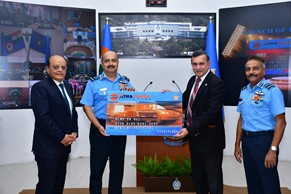
Source:
- IAF ties up with IOCL to revamp logistic management of fuel for vehicles
- Indian Air Force to use Fleet Card to draw fuel on the move
Image source:
‘City of Literature’: UNESCO
- Context: Kozhikode has been proposed by the Kerala Institute of Local Administration (KILA) to be branded as a ‘City of Literature’ with the help of UNESCO.
- UNESCO’s City of Literature programme is part of the wider Creative Cities Network.
- The Network was launched in 2004, and has member cities in seven creative fields that include: Crafts and Folk Art, Design, Film, Gastronomy, Media Arts, and Music.
- A city designated as Creative City of Literaturemust have a sufficient number of institutions taking care of the high level of its literary life and promoting literature.
- The city should have the ability and experience to organise different kinds of literary events, and an appropriate level of literaryeducation should be provided along with quality, quantity and diversity of literary activities.
- This branding would help Kozhikode get a global reach.

Source:
Image source:
Why strikes are less successful: HT
Essence: The trade unions had called for a general strike to demand reversal of the ongoing labour reforms and bank disinvestment processes, cash transfers for the poor, and reducing taxes on petrol and diesel. However, the response was weak except in Kerala and public sector banks. The reasons for decrease in support to such calls are due to shrinking workforce in the public sector companies and bipartisan consensus on economic reforms.
While the economic reforms have delivered goods, higher income growth and reduction in poverty, the recent economic slowdown and the pandemic’s disruption has reversed some of these gains. The ongoing inflationary spiral could further widen the structural inequalities in the economy. To fight such trends, we require strong working-class participation.
Why should you read this article?
- To know about the demands of the trade unions which gave the call for Bharat Band.
- To understand the reasons for the decrease in support to strike called by the trade unions.
- To know about the success of economic reforms and the current economic scenario.
Source:
State Budget and state of overall public spending in India: IE
Essence: Recently several state governments have presented their budget and it is an opportunity to evaluate it from the perspective of overall finances of the country.
Analysis of their budgets point towards the absence of rise in their revenue receipt and lack of fiscal consolidation. Money they were getting as part of GST (Goods and Services Tax) compensation is also scheduled to end by June 2022. Debt to GSDP (Gross State Domestic Product) ratio is also high and it will shift burden of reducing the general government debt over the medium term on the Centre.
Uncertainties surrounding states’ revenues and expenditures makes it difficult for the Central government to plan the amount of fiscal stimulus.
Why should you read this article?
- To understand the fiscal situation of state governments and its impact on overall fiscal uncertainty in the country.
Source:
India’s food response as ‘Vasudhaiva Kutumbakam’: TH
Essence: The author talks about the transformation of India’s agriculture sector from food import dependent to self-sustainable and now moving towards food exporting nation. India’s record production of 300m tonnes of cereals, having a buffer stock of 100m tonnes and export of 20m tonnes of rice and wheat speak volumes about the fostering grain production.
Providing for nutrition has become important post covid world as millions of people have fallen into abject poverty and malnutrition- pandemic shocks, conflicts, inequality have only risen. 650m people lived in chronic hunger, in 2019 and number of people at the brink of starvation has doubled to 270m post pandemic. India has assisted the World Food Program by providing food to Afghanistan, Zimbabwe, Yemen, etc. in the past. Due to supply constraints, people who need such assistance has only increased post Russia-Ukraine war.
India runs various safety net programs under National Food Security Act, 2013- TPDS, Mid-day meal, ICDS, etc; public procurement and buffer stock policy. The PM Garib Kalyan Anna Yojana has provided food assistance to 800m persons of the country during covid times.
The World Food Program won the Nobel Peace Prize in 2020 and India, the hearts of global leaders with its generous programs under the adage- Vasudhaiva Kutumbakam (the world is our home).
Why should you read this article?
- To understand India’s growth to self-sufficiency in food production.
- To know the level of nutrition insecurity around the world.
Source:
From Animal Driven Carts to E-rickshaw
Background
Animal driven carts amidst the hustle and bustle of Delhi’s busy roads is not a surprising view. They are used for various purposes, from selling vegetables to transportation of goods.
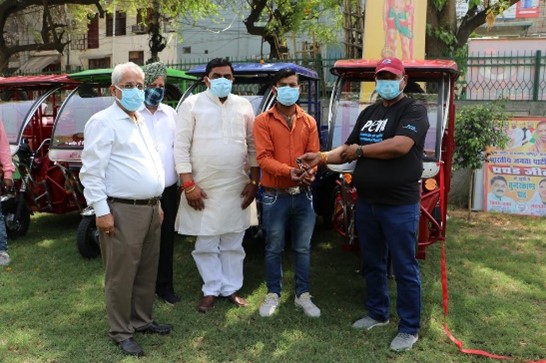
An initiative from Animal Driven Carts to E-rickshaw:
- People for the Ethical Treatment of Animals (PETA) launched the Delhi Mechanisation Project to convert animal driven carts to E-rickshaw in 2018.
- As per the initiative, the owners of the animals carts are provided with 60000 rupees to buy e-rickshaw to carry out their day to day business.
- The animals that were used are shifted to dedicated sanctuary in UP and Maharashtra where they can spent the rest of their lives.
- The owners themselves admitted that life has become easier and more dignified after they started using these battery driven rickshaws.
- The maintenance of these animals took major chunk of the income of these families forcing them to live in poverty.
Quote: “The greatness of a nation and its moral progress can be judged by the way its animals are treated.”- Mahatma Gandhi
Source:
Share the article
Get Latest Updates on Offers, Event dates, and free Mentorship sessions.

Get in touch with our Expert Academic Counsellors 👋
FAQs
UPSC Daily Current Affairs focuses on learning current events on a daily basis. An aspirant needs to study regular and updated information about current events, news, and relevant topics that are important for UPSC aspirants. It covers national and international affairs, government policies, socio-economic issues, science and technology advancements, and more.
UPSC Daily Current Affairs provides aspirants with a concise and comprehensive overview of the latest happenings and developments across various fields. It helps aspirants stay updated with current affairs and provides them with valuable insights and analysis, which are essential for answering questions in the UPSC examinations. It enhances their knowledge, analytical skills, and ability to connect current affairs with the UPSC syllabus.
UPSC Daily Current Affairs covers a wide range of topics, including politics, economics, science and technology, environment, social issues, governance, international relations, and more. It offers news summaries, in-depth analyses, editorials, opinion pieces, and relevant study materials. It also provides practice questions and quizzes to help aspirants test their understanding of current affairs.
Edukemy's UPSC Daily Current Affairs can be accessed through:
- UPSC Daily Current Affairs can be accessed through Current Affairs tab at the top of the Main Page of Edukemy.
- Edukemy Mobile app: The Daily Current Affairs can also be access through Edukemy Mobile App.
- Social media: Follow Edukemy’s official social media accounts or pages that provide UPSC Daily Current Affairs updates, including Facebook, Twitter, or Telegram channels.

